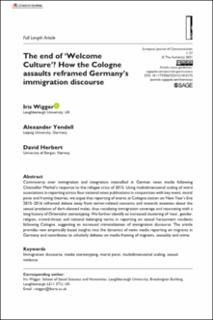| dc.contributor.author | Wigger, Iris | |
| dc.contributor.author | Yendell, Alexander | |
| dc.contributor.author | Herbert, David Eric John | |
| dc.date.accessioned | 2022-04-11T08:07:49Z | |
| dc.date.available | 2022-04-11T08:07:49Z | |
| dc.date.created | 2022-01-27T10:25:54Z | |
| dc.date.issued | 2021 | |
| dc.identifier.issn | 0267-3231 | |
| dc.identifier.uri | https://hdl.handle.net/11250/2990862 | |
| dc.description.abstract | Controversy over immigration and integration intensified in German news media following Chancellor Merkel’s response to the refugee crisis of 2015. Using multidimensional scaling of word associations in reporting across four national news publications in conjunction with key event, moral panic and framing theories, we argue that reporting of events at Cologne station on New Year’s Eve 2015–2016 reframed debate away from terror-related concerns and towards anxieties about the sexual predation of dark-skinned males, thus racializing immigration coverage and resonating with a long history of Orientalist stereotyping. We further identify an increased clustering of ‘race’, gender, religion, crowd-threat and national belonging terms in reporting on sexual harassment incidents following Cologne, suggesting an increased criminalization of immigration discourse. The article provides new empirically based insights into the dynamics of news media reporting on migrants in Germany and contributes to scholarly debates on media framing of migrants, sexuality and crime. | en_US |
| dc.language.iso | eng | en_US |
| dc.publisher | Sage | en_US |
| dc.rights | Navngivelse-Ikkekommersiell 4.0 Internasjonal | * |
| dc.rights.uri | http://creativecommons.org/licenses/by-nc/4.0/deed.no | * |
| dc.title | The end of ‘Welcome Culture’? How the Cologne assaults reframed Germany’s immigration discourse | en_US |
| dc.type | Journal article | en_US |
| dc.type | Peer reviewed | en_US |
| dc.description.version | publishedVersion | en_US |
| dc.rights.holder | Copyright 2021 The Author(s) | en_US |
| cristin.ispublished | true | |
| cristin.fulltext | original | |
| cristin.qualitycode | 2 | |
| dc.identifier.doi | 10.1177/02673231211012173 | |
| dc.identifier.cristin | 1991030 | |
| dc.source.journal | European Journal of Communication | en_US |
| dc.source.pagenumber | 21-47 | en_US |
| dc.identifier.citation | European Journal of Communication. 2021, 37 (1), 21-47. | en_US |
| dc.source.volume | 37 | en_US |
| dc.source.issue | 1 | en_US |

